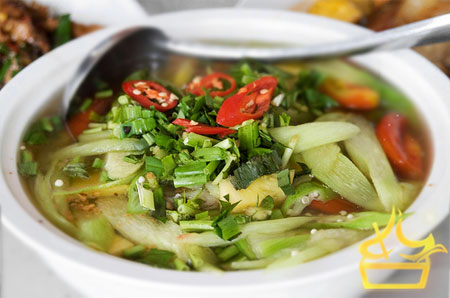Ever seen construction workers drinking hot tea in the blazing early-afternoon sun? Ever seen office workers hunkering down to piping hot bowls of soup in the midday heat?
 They do it because hot liquids actually help cool the body. Drinking beverages that are too cold can confuse the body into thinking it is cold, and often slows its reaction to the heat, whereas hot soups and teas have the opposite effect. Canh chua is one of Vietnam’s most famous dishes and is especially good on hot summer days. People from different regions in Vietnam cook canh chua with different local vegetables, fruits, and other ingredients. As canh chua blends a natural fresh sour taste with the vegetables and fruits in the soup, it goes very well with steamed rice, a staple on the Vietnamese table. On hot summer days, people tend to have smaller appetites and often forgo steamed rice. With the addition of canh chua’s refreshing and cool flavors, however, it becomes easier to have one or two bowls of steamed rice with lunch or dinner. Canh chua is a nice combination of vegetables, fish, pork, or snails, along with a vegetable or fruit to produce the soup’s sour taste. Northerners typically cook canh chua with tamarind leaves, qua sau (Dracontomelom a sour summer fruit in the north of Vietnam), pickles, green mangoes, qua doc (another sour fruit), tomatoes, and lemon or kum quat. Variations include canh chua sau thit nac (sau fruit cooked with ground pork and shallots), canh chua rau muong (boiled morning glory with lemon juice, boiled sau fruit, or boiled tamarind leaves) andcanh chua ca (fish soup cooked with green mangoes and shallots). In the South, tamarind fruit and pineapple are the favored ingredients.Canh chua ca loc (canh chua with snakehead fish) with pineapple is one of the most popular variations, and uses many local ingredients from the rich Mekong Delta. Yet northern and southern takes on canh chua fall into two basic categories. The first one is very simple and merely requires morning glory leaves, which are boiled either with tamarind leaves or qua sau. It takes a very short time (around 10 minutes) to make this dish. For this canh chua style, one would boil 4 or 5 little qua sau fruits together with the morning glory. After that the cook uses a small spoon to grind the boiled qua sau in a small bowl of nuoc mam to make the soup’s flavoring sauce. Two boiled qua sau are then ground and added to the soup, which gives a very fresh sour taste that rises in perfect contrast to hearty and fragrant white rice. Fresh boiled vegetables and sour soup served with rice is considered an essential summer dish in Vietnam. If one uses tamarind leaves for cooking, adding the tamarind only after removing the boiled morning glory will help preserve the morning glory’s deep green hue. “On a hot summer day, I don’t sell many other vegetables beyond morning glory, qua sau, tamarind leaves and fruit, and lemon,” said Ms. Tuoi, a vegetable vendor on Phan Huy Chu Street in Hanoi’s Hoan Kiem District. “These ingredients are for canh chua, and I sell a lot of them.” Another version of canh chua is more time consuming to make. There are three basic ingredients to prepare: a protein such as fish, pork, or snails; one or more vegetables; and a fruit for its citric acid. This fruit can be pineapple, green mangoes and tamarind leave and fruit. Add fried shallots, spring onions, and other herbs, and one will have a delicious canh chua. Canh sau chua suon (qua sau and pork ribs) is a very popular dish in Hanoi. In the past, a lunch consisting of only one dish such as canh sau chua suon was a good option for a busy mother. With this dish, all one has to do is cook a pork chop with a bit of salt and fish sauce and then add somequa sau and water to the mixture. When the dish is cooked one uses a spoon to grind qua sau and then add it again to the pot with some shallots. Canh chua ca (sour fish soup) is a popular dish in both the north and south of Vietnam. In the north, people like to marinate the food before cooking. A cook will usually fry the fish a bit before boiling with water to make the soup. By frying the fish it’s possible to keep the shape of it after cooking with water and decrease the fishy smell of the fish. In the south, canh chua ca loc (canh chua with snakehead fish) is a very rich dish. It’s cooked with pineapple, tomatoes and a bit of vinegar, as well as shallots and other herbs such as ngo, which are all added after the fish is cooked to preserve the fresh taste of the ingredients. After the soup is cooked, fried shallots will be sprinkled atop the soup, to add more fragrance to the dish. Canh chua is a simple but fresh and easy to cook dish which provides a lot of vitamins to provide relief from the heat. |
No comments:
Post a Comment